Abstract
A decrease in the in vitro sensitivity to acyclovir (ACV) was observed in successive isolates of herpes simplex virus type 1 from three immunocompromised patients during intravenous therapy with this drug. The ACV-resistant isolate from patient 1 was cross-resistant to dihydroxypropoxymethylguanine and bromovinyldeoxyuridine, but still susceptible to three fluoro-substituted pyrimidines, 2'-fluoro-5-iodo-1-beta-D-arabinofuranosylcytosine (FIAC), 2'-fluoro-5-iodo-1-beta-D-arabinofuranosyluracil (FIAU), and 2'-fluoro-5-iodo-1-beta-D-arabinofuranosylthymine (FMAU). The thymidine kinase (TK) from the resistant isolate showed a 50-fold or greater reduction in affinity for thymidine, FIAU, FMAU, and ACV, but the total enzyme activity was similar to that of the sensitive isolate. The ACV-resistant isolate from patient 2 was also resistant to dihydroxypropoxymethylguanine, bromovinyldeoxyuridine, and the fluoro-substituted compounds; TK activity for this isolate was less than 1% of the patient's pretherapy isolate. An isolate obtained during a subsequent recurrence in patient 2 was susceptible to ACV and the other TK-dependent agents. The ACV-resistant isolate from patient 3 was partially resistant to FIAC and FIAU but still susceptible to FMAU; the viral TK had a 10-fold-lower affinity for ACV, FIAU, and FMAU than did the sensitive pretherapy isolate, while the level of TK activity detected was reduced to 6%. In none of the isolates studied was a change in sensitivity to phosphonoformic acid observed. Compared with the corresponding pretherapy ACV-sensitive isolates, there was a 30-fold decrease in neurovirulence for mice of the two drug-resistant isolates with diminished levels of thymidine-phosphorylating activity and no change in virulence for the third isolate. These findings indicate that mixed patterns of drug-resistance to TK-dependent antiviral compounds can occur in clinical isolates, resulting from changes in either the amount or the affinity of viral TK activity.
Full text
PDF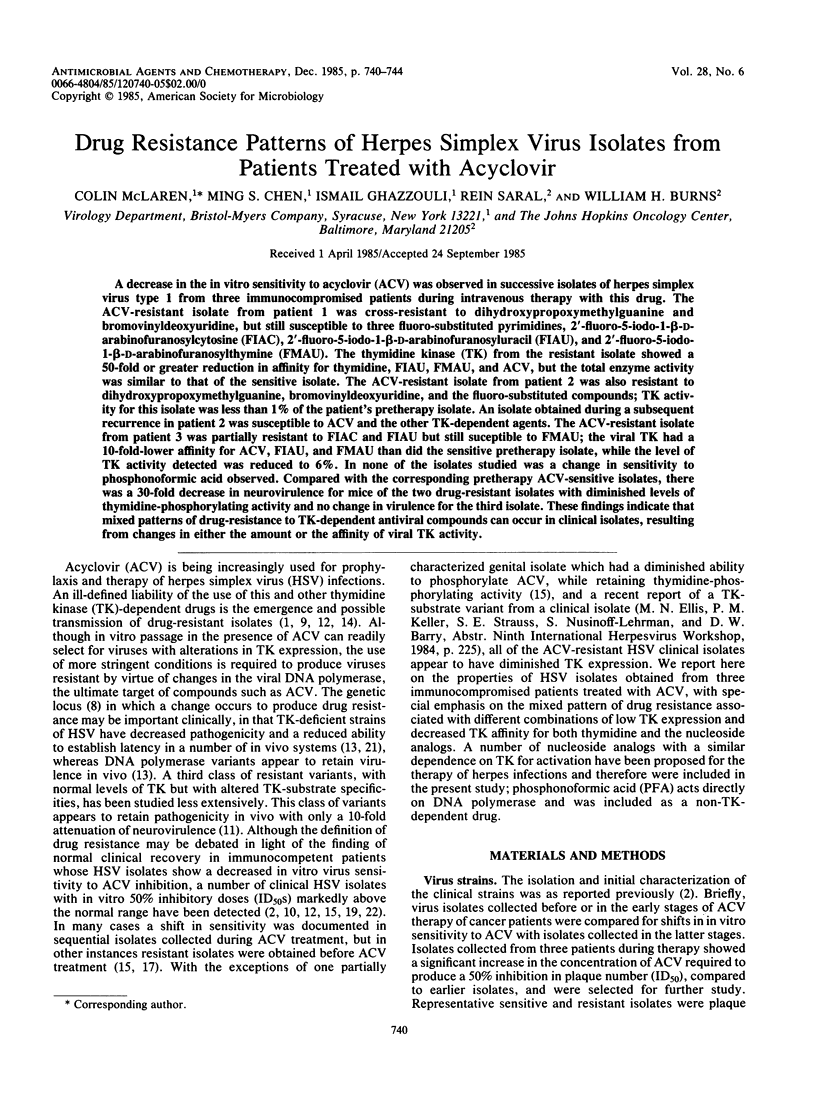
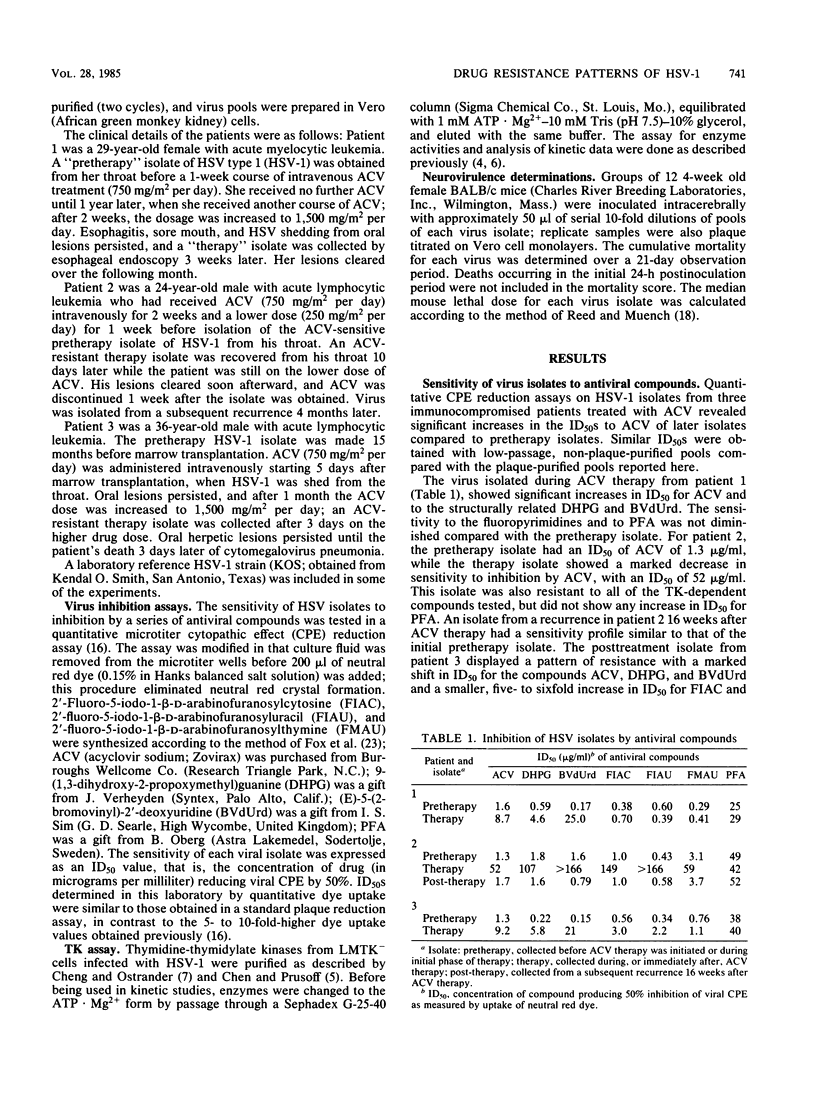
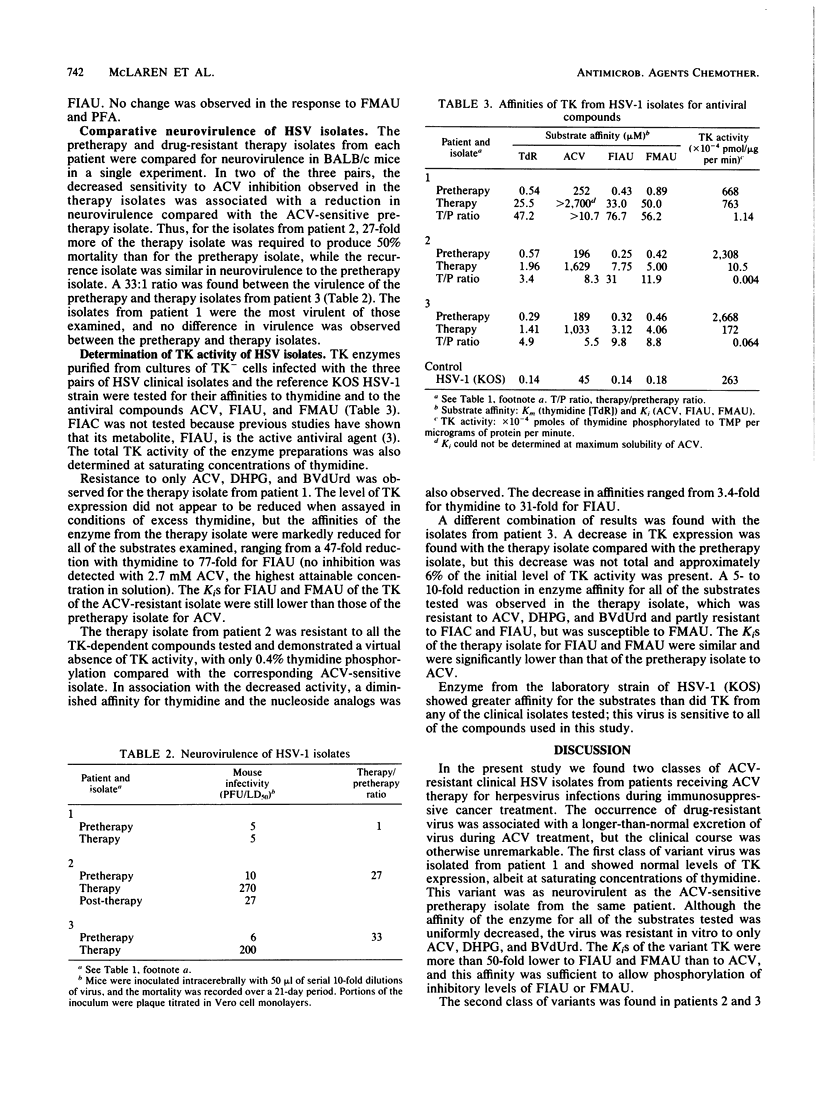
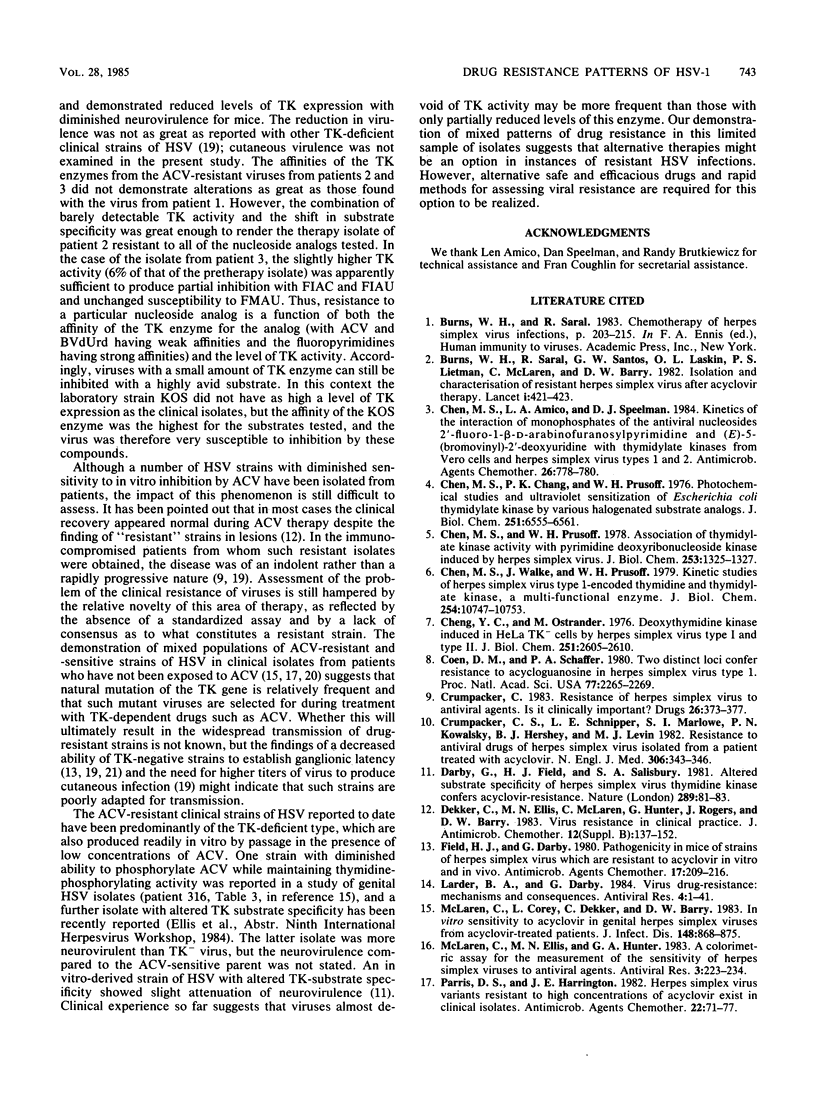
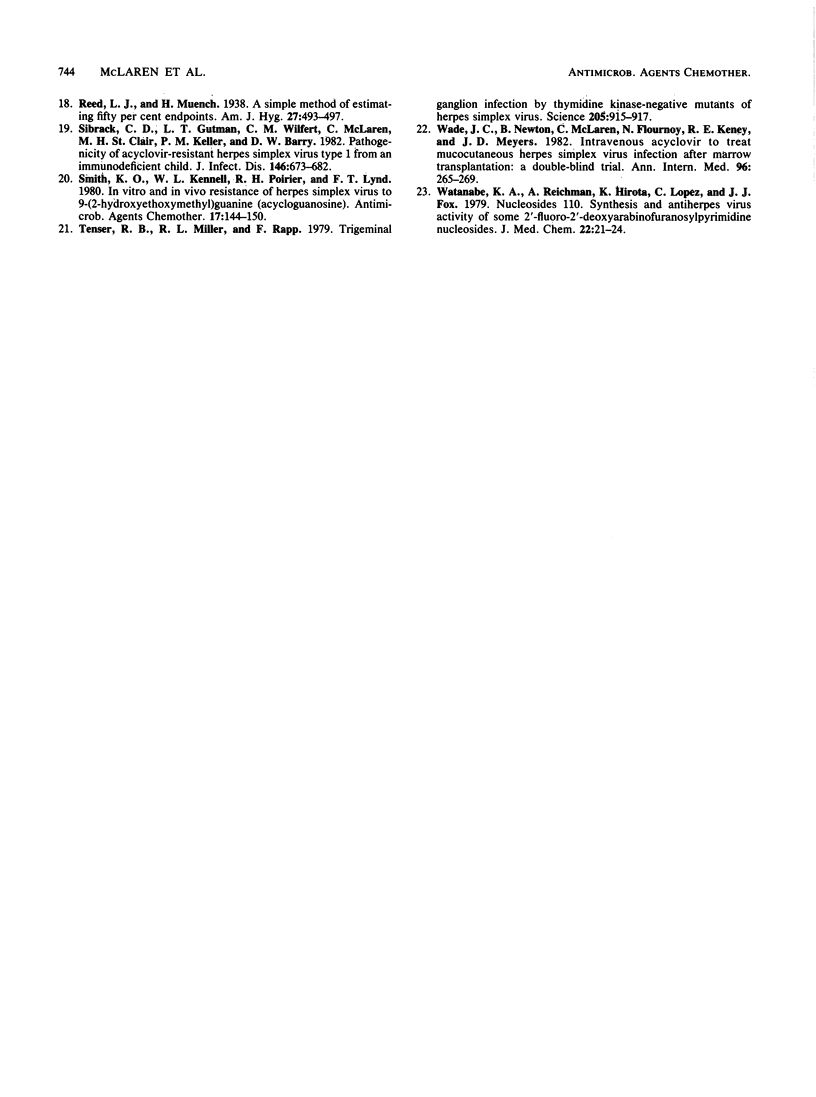
Selected References
These references are in PubMed. This may not be the complete list of references from this article.
- Burns W. H., Saral R., Santos G. W., Laskin O. L., Lietman P. S., McLaren C., Barry D. W. Isolation and characterisation of resistant Herpes simplex virus after acyclovir therapy. Lancet. 1982 Feb 20;1(8269):421–423. doi: 10.1016/s0140-6736(82)91620-8. [DOI] [PubMed] [Google Scholar]
- Chen M. S., Amico L. A., Speelman D. J. Kinetics of the interaction of monophosphates of the antiviral nucleosides 2'-fluoro-1-beta-D-arabinofuranosylpyrimidine and (E)-5-(2-bromovinyl)-2'-deoxyuridine with thymidylate kinases from Vero cells and herpes simplex virus types 1 and 2. Antimicrob Agents Chemother. 1984 Nov;26(5):778–780. doi: 10.1128/aac.26.5.778. [DOI] [PMC free article] [PubMed] [Google Scholar]
- Chen M. S., Chang P. K., Prusoff W. H. Photochemical studies and ultraviolet sensitization of Escherichia coli thymidylate kinase by various halogenated substrate analogs. J Biol Chem. 1976 Nov 10;251(21):6555–6561. [PMC free article] [PubMed] [Google Scholar]
- Chen M. S., Prusoff W. H. Association of thymidylate kinase activity with pyrimidine deoxyribonucleoside kinase induced by herpes simplex virus. J Biol Chem. 1978 Mar 10;253(5):1325–1327. [PubMed] [Google Scholar]
- Chen M. S., Walker J., Prusoff W. H. Kinetic studies of herpes simplex virus type 1-encoded thymidine and thymidylate kinase, a multifunctional enzyme. J Biol Chem. 1979 Nov 10;254(21):10747–10753. [PubMed] [Google Scholar]
- Cheng Y. C., Ostrander M. Deoxythymidine kinase induced in HeLa TK- cells by herpes simplex virus type I and type II. II. Purification and characterization. J Biol Chem. 1976 May 10;251(9):2605–2610. [PubMed] [Google Scholar]
- Coen D. M., Schaffer P. A. Two distinct loci confer resistance to acycloguanosine in herpes simplex virus type 1. Proc Natl Acad Sci U S A. 1980 Apr;77(4):2265–2269. doi: 10.1073/pnas.77.4.2265. [DOI] [PMC free article] [PubMed] [Google Scholar]
- Crumpacker C. S., Schnipper L. E., Marlowe S. I., Kowalsky P. N., Hershey B. J., Levin M. J. Resistance to antiviral drugs of herpes simplex virus isolated from a patient treated with acyclovir. N Engl J Med. 1982 Feb 11;306(6):343–346. doi: 10.1056/NEJM198202113060606. [DOI] [PubMed] [Google Scholar]
- Crumpacker C. Resistance of herpes simplex virus to antiviral agents. Is it clinically important? Drugs. 1983 Nov;26(5):373–377. doi: 10.2165/00003495-198326050-00001. [DOI] [PubMed] [Google Scholar]
- Darby G., Field H. J., Salisbury S. A. Altered substrate specificity of herpes simplex virus thymidine kinase confers acyclovir-resistance. Nature. 1981 Jan 1;289(5793):81–83. doi: 10.1038/289081a0. [DOI] [PubMed] [Google Scholar]
- Dekker C., Ellis M. N., McLaren C., Hunter G., Rogers J., Barry D. W. Virus resistance in clinical practice. J Antimicrob Chemother. 1983 Sep;12 (Suppl B):137–152. doi: 10.1093/jac/12.suppl_b.137. [DOI] [PubMed] [Google Scholar]
- Field H. J., Darby G. Pathogenicity in mice of strains of herpes simplex virus which are resistant to acyclovir in vitro and in vivo. Antimicrob Agents Chemother. 1980 Feb;17(2):209–216. doi: 10.1128/aac.17.2.209. [DOI] [PMC free article] [PubMed] [Google Scholar]
- Larder B. A., Darby G. Virus drug-resistance: mechanisms and consequences. Antiviral Res. 1984 Apr;4(1-2):1–42. doi: 10.1016/0166-3542(84)90023-8. [DOI] [PubMed] [Google Scholar]
- McLaren C., Corey L., Dekket C., Barry D. W. In vitro sensitivity to acyclovir in genital herpes simplex viruses from acyclovir-treated patients. J Infect Dis. 1983 Nov;148(5):868–875. doi: 10.1093/infdis/148.5.868. [DOI] [PubMed] [Google Scholar]
- McLaren C., Ellis M. N., Hunter G. A. A colorimetric assay for the measurement of the sensitivity of herpes simplex viruses to antiviral agents. Antiviral Res. 1983 Nov;3(4):223–234. doi: 10.1016/0166-3542(83)90001-3. [DOI] [PubMed] [Google Scholar]
- Parris D. S., Harrington J. E. Herpes simplex virus variants restraint to high concentrations of acyclovir exist in clinical isolates. Antimicrob Agents Chemother. 1982 Jul;22(1):71–77. doi: 10.1128/aac.22.1.71. [DOI] [PMC free article] [PubMed] [Google Scholar]
- Sibrack C. D., Gutman L. T., Wilfert C. M., McLaren C., St Clair M. H., Keller P. M., Barry D. W. Pathogenicity of acyclovir-resistant herpes simplex virus type 1 from an immunodeficient child. J Infect Dis. 1982 Nov;146(5):673–682. doi: 10.1093/infdis/146.5.673. [DOI] [PubMed] [Google Scholar]
- Smith K. O., Kennell W. L., Poirier R. H., Lynd F. T. In vitro and in vivo resistance of herpes simplex virus to 9-(2-hydroxyethoxymethyl)guanine (acycloguanosine). Antimicrob Agents Chemother. 1980 Feb;17(2):144–150. doi: 10.1128/aac.17.2.144. [DOI] [PMC free article] [PubMed] [Google Scholar]
- Tenser R. B., Miller R. L., Rapp F. Trigeminal ganglion infection by thymidine kinase-negative mutants of herpes simplex virus. Science. 1979 Aug 31;205(4409):915–917. doi: 10.1126/science.224454. [DOI] [PubMed] [Google Scholar]
- Wade J. C., Newton B., McLaren C., Flournoy N., Keeney R. E., Meyers J. D. Intravenous acyclovir to treat mucocutaneous herpes simplex virus infection after marrow transplantation: a double-blind trial. Ann Intern Med. 1982 Mar;96(3):265–269. doi: 10.7326/0003-4819-96-3-265. [DOI] [PubMed] [Google Scholar]
- Watanabe K. A., Reichman U., Hirota K., Lopez C., Fox J. J. Nucleosides. 110. Synthesis and antiherpes virus activity of some 2'-fluoro-2'-deoxyarabinofuranosylpyrimidine nucleosides. J Med Chem. 1979 Jan;22(1):21–24. doi: 10.1021/jm00187a005. [DOI] [PubMed] [Google Scholar]


